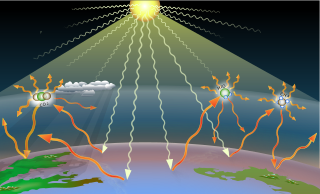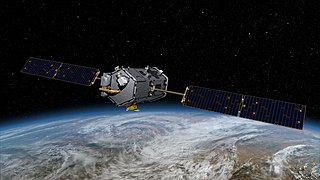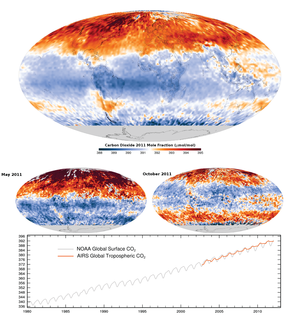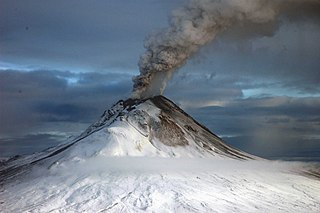 W
WA greenhouse gas (sometimes abbreviated GHG) is a gas that absorbs and emits radiant energy within the thermal infrared range. Greenhouse gases cause the greenhouse effect on planets. The primary greenhouse gases in Earth's atmosphere are water vapor (H2O), carbon dioxide (CO2), methane (CH4), nitrous oxide (N2O), and ozone (O3). Without greenhouse gases, the average temperature of Earth's surface would be about −18 °C (0 °F), rather than the present average of 15 °C (59 °F). The atmospheres of Venus, Mars and Titan also contain greenhouse gases.
 W
WThe Greenhouse Gases Observing Satellite ('GOSAT), also known as Ibuki , is an Earth observation satellite and the world's first satellite dedicated to greenhouse-gas-monitoring. It measures the densities of carbon dioxide and methane from 56,000 locations on the Earth's atmosphere. The GOSAT was developed by the Japan Aerospace Exploration Agency (JAXA) and launched on 23 January 2009, from the Tanegashima Space Center. Japan's Ministry of the Environment, and the National Institute for Environmental Studies (NIES) use the data to track gases causing the greenhouse effect, and share the data with NASA and other international scientific organizations.
 W
WThe Orbiting Carbon Observatory (OCO) is a NASA satellite mission intended to provide global space-based observations of atmospheric carbon dioxide. The original spacecraft was lost in a launch failure on 24 February 2009, when the payload fairing of the Taurus rocket which was carrying it failed to separate during ascent. The added mass of the fairing prevented the satellite from reaching orbit. It subsequently re-entered the atmosphere and crashed into the Indian Ocean near Antarctica. The replacement satellite, Orbiting Carbon Observatory-2, was launched 2 July 2014 aboard a Delta II rocket. The Orbiting Carbon Observatory-3, a stand-alone payload built from the spare OCO-2 flight instrument, was installed on the International Space Station's Kibō Exposed Facility in May 2019.
 W
WOrbiting Carbon Observatory-2 (OCO-2) is an American environmental science satellite which launched on 2 July 2014. A NASA mission, it is a replacement for the Orbiting Carbon Observatory which was lost in a launch failure in 2009. It is the second successful high-precision CO2 observing satellite, after GOSAT.
 W
WThe Orbiting Carbon Observatory-3 (OCO-3) is a NASA-JPL instrument designed to measure carbon dioxide in Earth's atmosphere. The instrument is mounted on the Japanese Experiment Module-Exposed Facility on board the International Space Station (ISS). OCO-3 was scheduled to be transported to space by a SpaceX Dragon from a Falcon 9 rocket on 30 April 2019, but the launch was delayed to 3 May, due to problems with the space station's electrical power system. This launch was further delayed to 4 May due to electrical issues aboard Of Course I Still Love You (OCISLY), the barge used to recover the Falcon 9’s first stage. OCO-3 was launched as part of CRS-17 on 4 May 2019 at 06:48 UTC. The nominal mission lifetime is 3 years.
 W
WAtmospheric methane is the methane present in Earth's atmosphere. Atmospheric methane concentrations are of interest because it is one of the most potent greenhouse gases in Earth's atmosphere. Atmospheric methane is rising.
 W
WThe Azolla event is a scenario hypothesized to have occurred in the middle Eocene epoch, around 49 million years ago, when blooms of the freshwater fern Azolla are thought to have happened in the Arctic Ocean. As they sank to the stagnant sea floor, they were incorporated into the sediment; the resulting draw-down of carbon dioxide has been speculated to have helped transform the planet from a "greenhouse Earth" state, hot enough for turtles and palm trees to prosper at the poles, to the current icehouse Earth known as the Late Cenozoic Ice Age.
 W
WBromochlorodifluoromethane (BCF), also referred to by the code numbers Halon 1211 and Freon 12B1, is a haloalkane with the chemical formula CF2ClBr. It is used for fire suppression, especially for expensive equipment.
 W
WCarbon dioxide (chemical formula CO2) is a colorless gas with a density about 53% higher than that of dry air. Carbon dioxide molecules consist of a carbon atom covalently double bonded to two oxygen atoms. It occurs naturally in Earth's atmosphere as a trace gas. The current concentration is about 0.04% (412 ppm) by volume, having risen from pre-industrial levels of 280 ppm. Natural sources include volcanoes, hot springs and geysers, and it is freed from carbonate rocks by dissolution in water and acids. Because carbon dioxide is soluble in water, it occurs naturally in groundwater, rivers and lakes, ice caps, glaciers and seawater. It is present in deposits of petroleum and natural gas. Carbon dioxide has a sharp and acidic odor and generates the taste of soda water in the mouth. However, at normally encountered concentrations it is odorless.
 W
WCarbon dioxide is an important trace gas in Earth's atmosphere. It is an integral part of the carbon cycle, a biogeochemical cycle in which carbon is exchanged between the Earth's oceans, soil, rocks and the biosphere. Plants and other photoautotrophs use solar energy to produce carbohydrate from atmospheric carbon dioxide and water by photosynthesis. Almost all other organisms depend on carbohydrate derived from photosynthesis as their primary source of energy and carbon compounds. CO2 absorbs and emits infrared radiation at wavelengths of 4.26 μm (2347 cm−1) and 14.99 μm (666 cm−1) and consequently is a greenhouse gas that plays a significant role in influencing Earth's surface temperature through the greenhouse effect.
 W
WThe CDP is an international non-profit organisation based in the United Kingdom, Germany and the United States of America that helps companies and cities disclose their environmental impact. It aims to make environmental reporting and risk management a business norm, driving disclosure, insight, and action towards a sustainable economy. Since 2002 over 8,400 companies have publicly disclosed environmental information through CDP.
 W
WCarbon Literacy is the awareness of climate change and the climate impacts of mankind's everyday actions. The term has been used in a range of contexts in scientific literature and in casual usage, but is most associated with The Carbon Literacy Project (CLP).
 W
WCarbon-neutral fuel is energy fuel or energy systems which have no net greenhouse gas emissions or carbon footprint. One class is synthetic fuel produced from renewable, sustainable or nuclear energy used to hydrogenate carbon dioxide directly captured from the air (DAC), recycled from power plant flue exhaust gas or derived from carbonic acid in seawater. Renewable energy sources include wind turbines, solar panels, and hydroelectric powerful power stations. Another type of renewable energy source is biofuel. Such fuels are potentially carbon-neutral because they do not result in a net increase in atmospheric greenhouse gases.
 W
WCarbon tetrachloride, also known by many other names (such as tetrachloromethane, also recognised by the IUPAC, carbon tet in the cleaning industry, Halon-104 in firefighting, and Refrigerant-10 in HVACR) is an organic compound with the chemical formula CCl4. It is a colourless liquid with a "sweet" smell that can be detected at low levels. It has practically no flammability at lower temperatures. It was formerly widely used in fire extinguishers, as a precursor to refrigerants and as a cleaning agent, but has since been phased out because of toxicity and safety concerns. Exposure to high concentrations of carbon tetrachloride (including vapor) can affect the central nervous system and degenerate the liver and kidneys. Prolonged exposure can be fatal.
 W
WTetrafluoromethane, also known as carbon tetrafluoride or R-14, is the simplest perfluorocarbon (CF4). As its IUPAC name indicates, tetrafluoromethane is the perfluorinated counterpart to the hydrocarbon methane. It can also be classified as a haloalkane or halomethane. Tetrafluoromethane is a useful refrigerant but also a potent greenhouse gas. It has a very high bond strength due to the nature of the carbon–fluorine bond.
 W
W1-Chloro-1,1-difluoroethane (HCFC-142b, also known by trade names including Freon-142b) is a hydrochlorofluorocarbon (HCFC) with the chemical formula CH3CClF2. It is primarily used as a refrigerant.
 W
WChloropentafluoroethane is a chlorofluorocarbon once used as a refrigerant. Its production and consumption has been banned since 1 January 1996 under the Montreal Protocol because of its ozone-depleting potential. It has a lifespan of 400 years.
 W
WClean agent FS 49 C2 is an environmentally engineered, human safe, fast extinguishing Clean Agent fire extinguishing gas for gaseous fire suppression installed in a suited fire suppression system. It is a gaseous solution of 60-80% tetrafluoroethane (R-134a), 10-30% pentafluoroethane (R-125) and 10-30% carbon dioxide (CO2). The Clean agent FS 49 C2 is an extinguishing gas mixture that suppresses fire while maintaining breathable concentrations of oxygen in the air. This makes it possible to extinguish a fire with less danger to people in the room at extinguishing concentrations in contrast to pure carbon dioxide (CO2) based fire suppression system which is deadly to humans when released. In the beginning the gas was called Halotron II B/FS49C2 but later only the name FS 49 C2 is used. Former fire chief Einar Gjessing made an article about the product to inform firemen how this gas works in case they need to enter a fire site with FS 49 C2.
 W
W1,1-Dichloro-1-fluoroethane is a haloalkane with the formula C2H3Cl2F. It is one of the three isomers of dichlorofluoroethane. It belongs to the hydrochlorofluorocarbon family (HCFC).
 W
W1,1-Difluoroethane, or DFE, is an organofluorine compound with the chemical formula C2H4F2. This colorless gas is used as a refrigerant, where it is often listed as R-152a (refrigerant-152a) or HFC-152a (hydrofluorocarbon-152a). It is also used as a propellant for aerosol sprays and in gas duster products. As an alternative to chlorofluorocarbons, it has an ozone depletion potential of zero, a lower global warming potential (124) and a shorter atmospheric lifetime (1.4 years).
 W
WFluorocarbons, sometimes referred to as perfluorocarbons or PFCs, are organofluorine compounds with the formula CxFy, i.e., they contain only carbon and fluorine. The terminology is not strictly followed and many fluorine-containing organic compounds are called fluorocarbons. Compounds with the prefix perfluoro- are hydrocarbons, including those with heteroatoms, wherein all C-H bonds have been replaced by C-F bonds. Fluorocarbons includes perfluoroalkanes, fluoroalkenes, fluoroalkynes, and perfluoroaromatic compounds. Fluorocarbons and their derivatives are used as fluoropolymers, refrigerants, solvents, and anesthetics.
 W
WThe greenhouse effect is the process by which radiation from a planet's atmosphere warms the planet's surface to a temperature above what it would be without this atmosphere.
 W
WThe North Australian Pastoral Company (NAPCO) is a large, privately owned, Australian cattle company which operates 13 cattle stations covering over 60,000 km2, managing about 200,000 cattle, in Queensland and the Northern Territory. It produces beef cattle which are grass fed and grain finished before sale to Australian meat processors who onsell beef to domestic and international customers.
 W
WHexafluoroethane is the perfluorocarbon counterpart to the hydrocarbon ethane. It is a non-flammable gas negligibly soluble in water and slightly soluble in alcohol. It is an extremely potent and long-lived greenhouse gas.
 W
WThe Integrated Carbon Observation System (ICOS) is a research infrastructure to quantify the greenhouse gas balance of Europe and adjacent regions. In November 2015 it received the international legal status of ERIC by decision of the European Commission. It is recognized by The European Strategy Forum on Research Infrastructures (ESFRI) as a landmark European research infrastructure. It consists of a harmonized network of long-term observation sites for the domains of atmosphere, ecosystems and ocean. The network is coordinated through its Head Office, the central data portal and central facilities including an atmosphere, ecosystem and ocean thematic center, and central analytical laboratories.
 W
WMethane ( or ) is a chemical compound with the chemical formula CH4 (one atom of carbon and four atoms of hydrogen). It is a group-14 hydride and the simplest alkane, and is the main constituent of natural gas. The relative abundance of methane on Earth makes it an economically attractive fuel, although capturing and storing it poses technical challenges due to its gaseous state under normal conditions for temperature and pressure.
 W
WNitrogen trifluoride is the inorganic compound with the formula NF3. This nitrogen-fluorine compound is a colorless, nonflammable gas with a slightly musty odor. It finds increasing use as an etchant in microelectronics. Nitrogen trifluoride is an extremely strong greenhouse gas.
 W
WNitrous oxide, commonly known as laughing gas or nitrous, is a chemical compound, an oxide of nitrogen with the formula N2O. At room temperature, it is a colourless non-flammable gas, with a slight metallic scent and taste. At elevated temperatures, nitrous oxide is a powerful oxidiser similar to molecular oxygen. It is soluble in water.
 W
WOzone, or trioxygen, is an inorganic molecule with the chemical formula O3. It is a pale blue gas with a distinctively pungent smell. It is an allotrope of oxygen that is much less stable than the diatomic allotrope O2, breaking down in the lower atmosphere to O2 (dioxygen). Ozone is formed from dioxygen by the action of ultraviolet (UV) light and electrical discharges within the Earth's atmosphere. It is present in very low concentrations throughout the latter, with its highest concentration high in the ozone layer of the stratosphere, which absorbs most of the Sun's ultraviolet (UV) radiation.
 W
WPerfluorotributylamine (PFTBA), also referred to as FC43, is a colorless liquid with the formula N(C4F9)3. The compound consists of three butyl groups connected to an amine center, in which all of the hydrogen atoms have been replaced with fluorine. The compound is produced for the electronics industry, along with other perfluoroalkylamines. The high degree of fluorination significantly reduces the basicity of the central amine due to electron-withdrawing effects.
 W
WWater is a polar inorganic compound that is at room temperature a tasteless and odorless liquid, which is nearly colorless apart from an inherent hint of blue. It is by far the most studied chemical compound and is described as the "universal solvent" and the "solvent of life." It is the most abundant substance on Earth and the only common substance to exist as a solid, liquid, and gas on Earth's surface. It is also the third most abundant molecule in the universe.
 W
WSulfur hexafluoride (SF6) or sulphur hexafluoride (British spelling), is an extremely potent and persistent man-made greenhouse gas that is primarily utilized as an electrical insulator and arc suppressant. It is inorganic, colorless, odorless, non-flammable, and non-toxic. SF6 has an octahedral geometry, consisting of six fluorine atoms attached to a central sulfur atom. It is a hypervalent molecule.
 W
WThe organic compound 1,1,1-trichloroethane, also known as methyl chloroform, is a chloroalkane. This colourless, sweet-smelling liquid was once produced industrially in large quantities for use as a solvent. It is regulated by the Montreal Protocol as an ozone-depleting substance and its use is being rapidly phased out.
 W
WVolcanic gases are gases given off by active volcanoes. These include gases trapped in cavities (vesicles) in volcanic rocks, dissolved or dissociated gases in magma and lava, or gases emanating from lava, from volcanic craters or vents. Volcanic gases can also be emitted through ground water heated by volcanic action.
 W
WWater vapor, water vapour or aqueous vapor is the gaseous phase of water. It is one state of water within the hydrosphere. Water vapor can be produced from the evaporation or boiling of liquid water or from the sublimation of ice. Water vapor is transparent, like most constituents of the atmosphere. Under typical atmospheric conditions, water vapor is continuously generated by evaporation and removed by condensation. It is less dense than most of the other constituents of air and triggers convection currents that can lead to clouds.
 W
WZero Carbon World is a charity registered in England and Wales. It is also a Limited liability company.